Chill out in the Atacama Desert
Close to Chile’s borders with Bolivia and Argentina, the town of San Pedro de Atacama is the base for exploration of the spare terrain of the Atacama Desert. The town is small, with adobe houses and a low-key atmosphere, a place with hotels and restaurants that tourists use as a base to venture into the outdoors nearby. While the word desert might suggest an area of uniform desolation, this destination is a place of variegated scenery, some that feel like it belong on another planet.
This is a stunning part of the world, and for families that like to see something truly different, it’s a piece of the planet that is definitely not run-of-the-mill. Working their way around the desert, adults and kids will encounter textures and colors likely to make their mouths open in awe. Expect to see deep blue lagoons, salt flats, geysers that produce fountains of steam, hot springs, an area called Valle de la Luna (or Valley of the Moon), and bodies of inland water that are so salty that visitors can effortlessly float in them.
Ride the Atlantic and Pacific waves
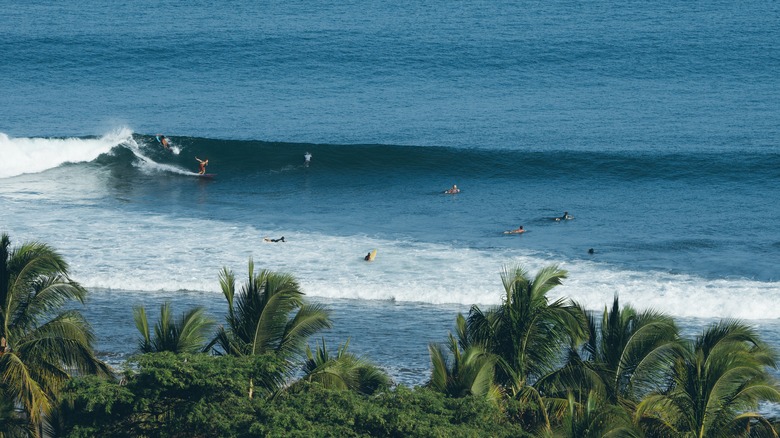
Both sides of the continent have excellent surfing; even off the water, families will find things to do to keep them busy. On the Pacific, a great spot for surfing is the Peruvian town of Mancorá, which is closer to the Ecuadorean city of Guayaquil than to the Peruvian capital of Lima. Thankfully, the water is warm, so wetsuits can often be foregone, and the waves aren’t overpowering, making it a good spot for newbies. There are many surf schools in the town, with Inka Warrior Surf School among them.
Off the boards, visitors can enjoy the languid charms of the town, from hanging out at the beach to eating at the many relaxed restaurants, and while Mancorá town has a bit of a party reputation, there are quiet places to stay on the outskirts. On the Atlantic, Florianópolis is the center of surfing in Brazil. Technically, Floripa, as it’s locally known, is the name of the large city on the west coast of Santa Caterina Island, but is regularly used to refer to the whole island. The island has fabulous beaches, quaint villages, an old fort, and an east coast lined with surf schools.
Scale the peaks of Patagonia
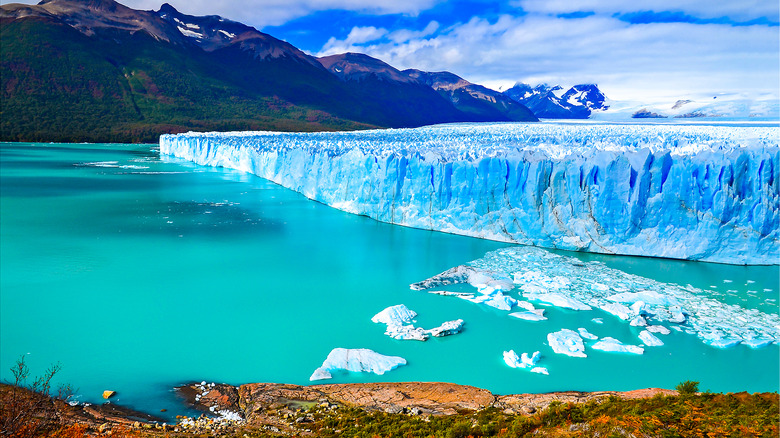
VarnaK/Shutterstock
The mountains and lakes of Patagonia, which spread across southern Argentina and Chile, are magnificent. For any family that prizes dramatic, breathtaking outdoor scenery, few places in the world match up to the natural pageantry here. In Argentina, the Perito Moreno Glacier is part of Los Glaciares National Park, a UNESCO World Heritage site, and it beautifully represents the archetypal image of a glacier — a deep wall of cool-blue ice with jagged tops that look almost razor-sharp.
Bariloche, also in Argentine Patagonia, has beautiful alpine lakes, snow-capped peaks, dense forests, and great hiking. In Chile, Torres del Paine National Park is a realm of brooding, menacing mountains, baby-blue lakes, fields of wildflowers, and clear, clean air that is invigorating. This is definitely a bucket-list destination, a UNESCO Biosphere Reserve, thanks to its rich variety of environments and the kind of place that photos can never do justice.
Snorkel the sublime in Brazil’s Fernando de Noronha
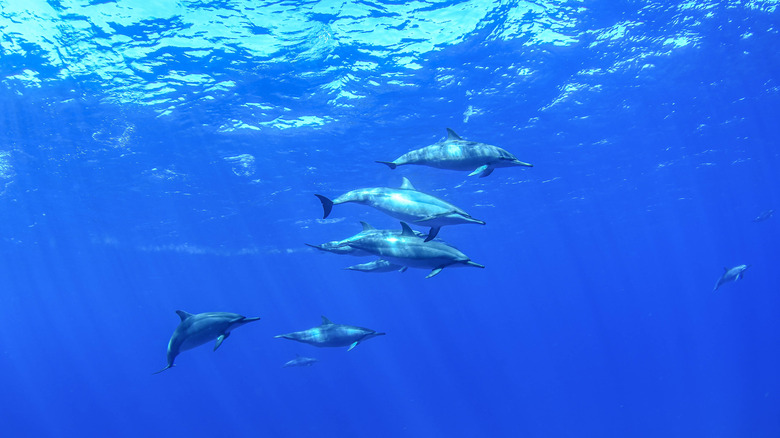
Cabuscaa/Getty Images
When describing the islands of the Fernando de Noronha National Park, UNESCO, which has designated them as part of a World Heritage site, presents them as an unfathomable magnificence. High praise indeed, but visitors will understand what the organization means upon seeing this archipelago of islands, a vestige of an old volcanic range of mountains. The 21 islands — one main one and 20 smaller siblings, with about 2,000 year-round inhabitants — mostly fall within the national park and sit hundreds of miles off the coast of mainland Brazil.
Visitors can expect towering, forested peaks, jagged coastlines, sweeping sandy bays, and ridiculously clear, inviting waters. Like the beaches, the marine life is stunning, with different sections of coral reefs and creatures such as rays, turtles, and Spinner dolphins frequently spotted in the waters here. Better yet, since the water is warm year-round, water-loving families won’t need wetsuits to stay comfortable in the ocean.
Walk on the moon in Bolivia
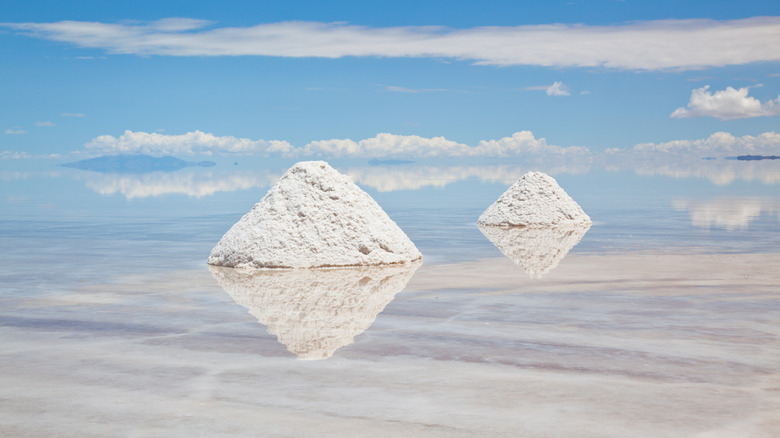
Onfokus/Getty Images
Located in the south of Bolivia, the otherworldly lunar landscapes of Salar de Uyuni (also known as the Uyuni Salt Flats) are probably as close as any of us will get to stepping on that big ball of cheese in the sky. The flats stretch across the high plains of Bolivia, thousands of feet above sea level, and according to official figures, there are billion tons of salt here.
Trips here usually extend across a few days for visitors that want to hit all the highlights of the salt pans, experiences such as the famed mirror effect, when a thin skin of water sits atop the salt, turning the plains into one large reflecting surface. The landscape is so enormous and flat that perspective takes on a whole new meaning, and families can use that to take fun photos. Kids might also enjoy the chance to stay in a hotel where the beds are made of salt.
Find a lost world in the highlands of Peru
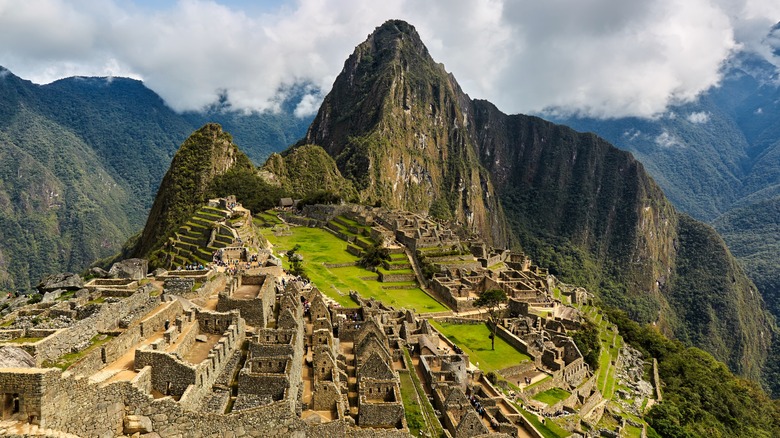
Sharan Prasad Anumolu/Shutterstock
The high-altitude town of Cusco is a delight for families, though we recommend taking the first few days to acclimatize to the low-oxygen air. This is where to explore the Choco Museum, with a workshop letting visitors make their chocolate bar, from picking the bean to the finished product. The Cusco Cathedral, built over a former Incan temple, is beautiful inside and out, a place brimming with sublime, refined artwork and ornate workmanship. Wandering the hilly, cobblestone streets of the city is also a joy.
Cusco is also the springboard for travel to Machu Picchu, a marvel that is a window into an old civilization. Taking a train from Cusco to the site is a fun family outing, and once at Machu Picchu, an Incan city in the Andes that was only discovered about a century ago, adults and kids can explore the sprawling citadel. Be sure to look out for the roving llamas.
Wonder at water between Brazil and Argentina
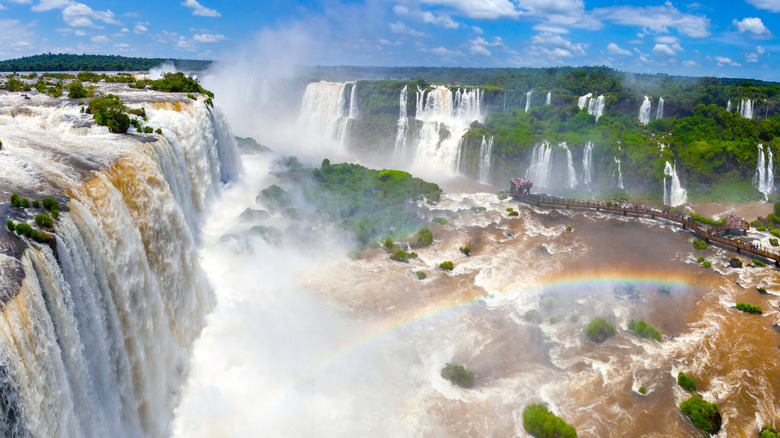
rocharibeiro/Shutterstock
The Niagara Falls are a striking sight, but the pair of cascades might seem a little ho-hum once you see the vast Iguazu Falls. Split between Argentina and Brazil, with the vast majority of the falls in the former, this horseshoe cascade is a spectacle in the true sense of the world. Rather than just appearing as one long sheet of water that drops over a precipice, Igauzu is a series of falls, with raging water surges dropping more than 250 feet.
There are platforms and walkways that allow travelers to get close to the drop, especially one section called the Devil’s Throat, where the power of the water is immense. For more adventure, boat rides bring visitors close to the bottom of the falls, another fun family activity. The falls sit within a national park, a UNESCO World Heritage site with plenty of hiking trails and the chance to spot local flora and fauna, including toucans and flamingos.
Eat and be merry in Lima
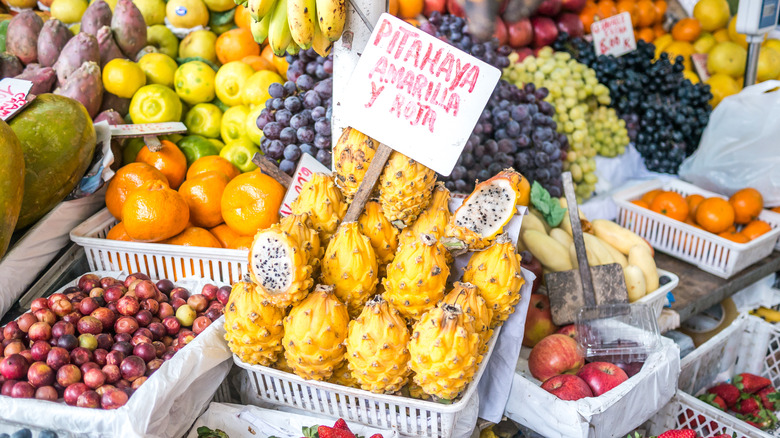
Sergio TB/Shutterstock
Some of the most scintillating food on the continent is in Peru, and culinary observers can identify many reasons for the rich depth of the cuisine. Take a look at the nation on a map, and what becomes evident is the vast geographic range within its borders — on one side is the Pacific Ocean, while elsewhere, the country yields to the Amazon basin and the Andes mountains. This has helped to create microclimates all over Peru, environments that allow a huge range of products to grow (visit Surquillo Market in Lima, and you’ll see what we mean).
Culturally, Peru has also welcomed large waves of immigrants from Asia, Europe, and Africa, all of which have influenced the culinary landscape, from the spices to the way seafood is prepared. For foodie families, an exciting, educational way to sate the stomach is a food tour of the capital and perhaps try some super-fresh ceviche. Lima Gourmet Company, for instance, offers five-hour tours that stop at city markets, Incan ruins, and street-food standouts.
Immerse yourself in nature in the Galápagos
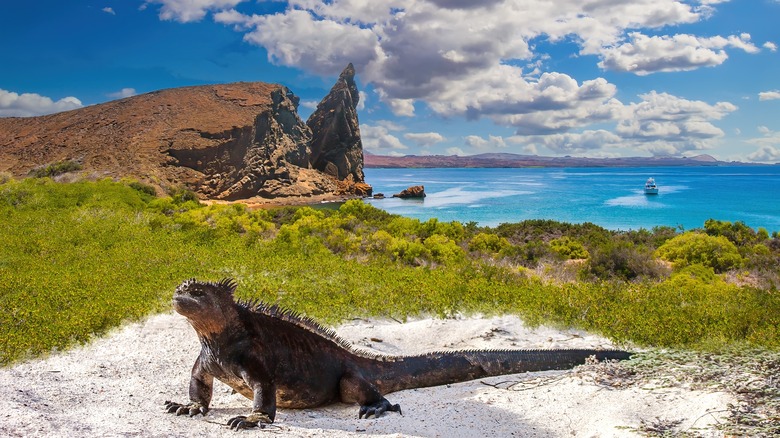
FOTOGRIN/Shutterstock
A group of islands that profoundly influenced Charles Darwin when he put forward his theories on evolution, the Galápagos, in Ecuador, have flora and fauna not to be missed. For families, this is another bucket-list place — some of its species aren’t found anywhere else. It is a destination that can be seen anytime, thanks to a location right by the Equator (this ensures the weather changes little throughout the year). The Galápagos tend to get busier in certain months — those coinciding with the summer vacations and end-of-year breaks in the United States and Europe.
Visitors access the islands either via a live-aboard boat, by booking lodging on one of the islands, or by taking day trips to other isles. Either way, families might see blue-footed boobies, penguins, nesting turtles, sea lions, large lizards, and plenty of avian life, while divers will be captivated by rays, sharks, and seals.
Hit the slopes in Argentina and Chile
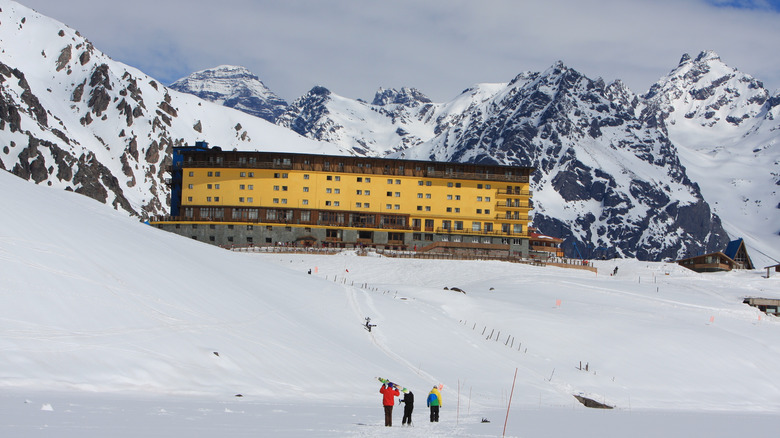
Seastock/Getty Images
As noted earlier, the two countries that unfurl all the way to the bottom of South America — Argentina and Chile — have some wild mountainous terrain, allowing for incredible skiing in both. One of the most popular spots in Chile is Portillo, where a bright yellow hotel sits at the base of the valley. The ski area has more than 1,200 acres of terrain for skiers and snowboarders to explore, and even beginner families can look forward to slopes that are groomed every night.
Since the lodging here is limited to the hotel and some chalets and lodges, Portillo never gets ridiculously busy, and visitors are unlikely to encounter long lines at the lifts. The ski season includes July, August, and September, allowing U.S. skiers a chance to get a summer fix. Catedral Alta Patagonia, in Argentina’s San Carlos de Bariloche, is a huge ski resort with 7,000 beds for tourists, 29 ski lifts, and super skiing during the American summer.
Ride the rails through the jungles of Colombia
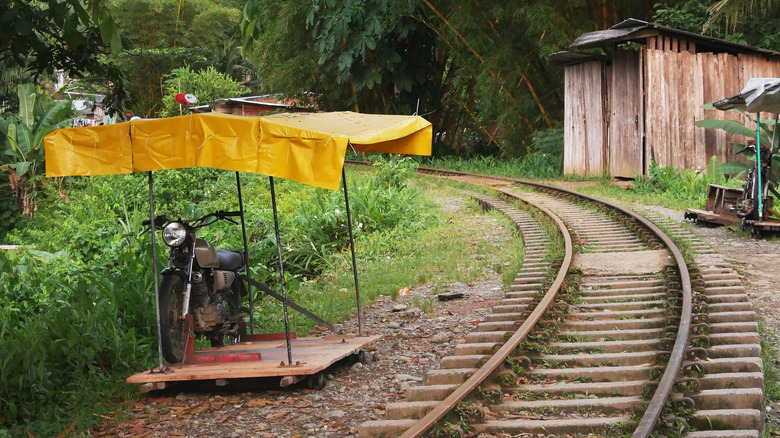
Nicolas Quenson/Shutterstock
For an adventure that is a little off-the-beaten-path and quite unique — which means it will give your family some real bragging rights — visitors should head to the San Cipriano Natural Reserve. An area of unspoiled, natural beauty in the forest and jungles near Cali, the reserve sits by the Danubio River. The water lets visitors enjoy the wilderness in a variety of ways, from tubing trips to dips in small pools.
However, the real appeal of a trip to this part of Colombia for any traveler, young or old, is the chance to ride a “brujita” (it roughly translates to “little witch”), a cobbled-together mode of transport that is both visionary and rudimentary. The set-up involves motorcycles rigged to run along train rails, pushing carriages at impressive speeds through the jungle. It’s a thrilling adventure and not something you are likely to find anywhere else on the continent or perhaps even the world.
Cruise with critters along the Amazon
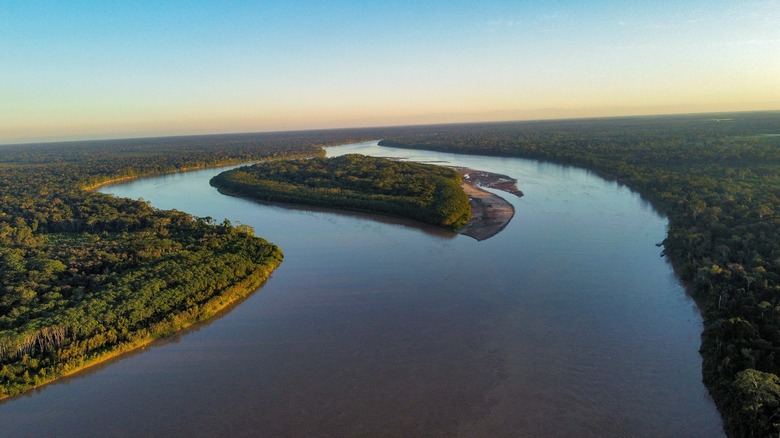
jonathan cabell/Shutterstock
A visit to South America wouldn’t be complete without some time on the Amazon, a river that extends for about 4,000 miles through the continent and that lends its name to a huge rainforest and basin. A waterway between the Andes of Peru and the Atlantic Ocean, it is known for its wealth of flora and fauna. While deforestation and commercial exploitation have negatively affected the Amazon rainforest, it remains a grand marvel of nature and is a treat to explore: many cruises ply its waters.
Vessels are small, enabling them to navigate the inland waters nimbly, and this size allows passengers to have an intimate experience in the basin — many trips actually wind along a tributary of the Amazon rather than the river itself. During a sailing, visitors might see dolphins capybara (imagine a giant hamster), go for a swim, and even interact with local villagers.
Climb to Rio de Janeiro’s iconic statue
![]()
Diego Grandi/Shutterstock
A number of places are totems of Brazil’s carnival hub, among them beaches like Copacabana and Ipanema that the whole family will love. But are any sites more uniquely iconic than the Christ the Redeemer statue, a vision in white whose outstretched arms seem to welcome all? Located on top of Mount Corcovado, the large replica of Christ, figuratively and literally, looks over the city, a concrete-and-tile colossus almost 100 feet tall. It is a mouthwatering expression of religious art, a fun site to visit, and offers incredible city vistas.
Completed in 1931, the statue was only accessible by foot for many decades, though mechanized modes of transportation — escalators and elevators — debuted in 2002, making the ascent less strenuous. Today, the trip up to Cristo Redentor, as it is known in Portuguese, is made by train, by tourist bus or taxi, or on foot. From the viewing deck under the statue, shaped vaguely like a cross, the panoramas of urban Rio and its surrounding mountains are truly breathtaking, worthy of pictures to put in the family album.
Take a seaside stroll in Montevideo
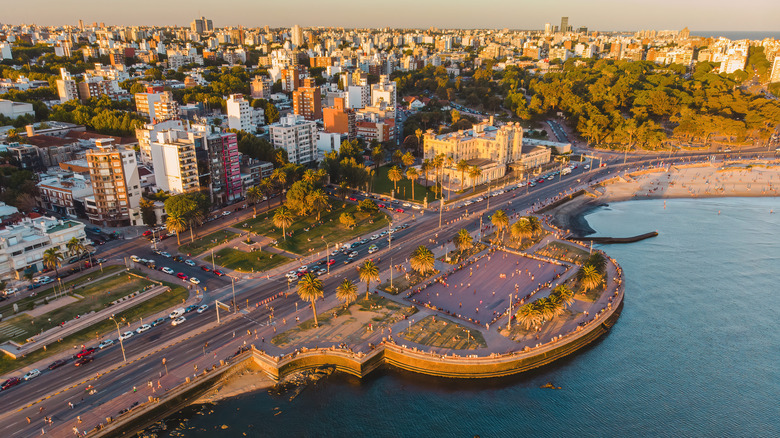
Drone 5/Shutterstock
In the Uruguayan capital of Montevideo, La Rambla skirts the waterfront for miles and is a great way to see different parts of the city. A leisurely stroll along this promenade will allow families to really get under the skin of the city to encounter different neighborhoods while easily getting in the day’s steps. The walkway winds along the Río de la Plata and is populated with locals and visitors keen on enjoying the outdoors, for exercise, as a spot to do some fishing, or just for the simple pleasure of getting some air.
Along the way, travelers will encounter green spaces, beaches, boîtes to grab a bite, pieces of public art, ships, museums, busy shopping malls, and old city walls. La Rambla extends for about 13 miles and passes important public buildings such as the Palacio Salvo and the Hospital de Clínicas, both completed in the 1920s, making it a look into the past and a celebration of the present.
Shop till you drop in an Ecuadorian market
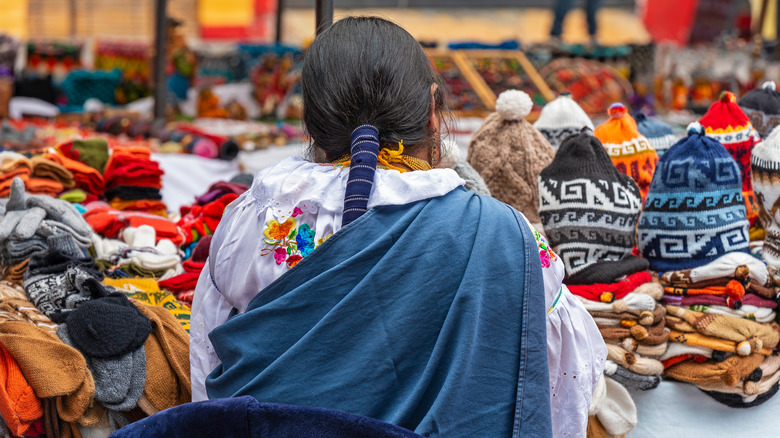
SL-Photography/Shutterstock
A vast market in Ecuador, Otavalo is most rewarding for its plethora of indigenous items for sale. Technically known as Plaza de los Ponchos market, it’s generally referred to as Otavalo, the town in the highlands northeast of Quito where the bazaar takes place. The market itself is huge, and while it is open every day of the year, Wednesday and Saturday tend to be when it is at its most fertile. For weaved goods — textiles, rugs, clothing, and so on — this market is a gold mine since weaving is a regional tradition that dates back centuries.
The colors of the fabrics are vibrantly spellbinding, and visitors will find goods that make fabulous gifts, from carvings to jewelry to clothes to accessories. Beyond the market, the area has much to captivate families, from the pretty San Pablo Lake, where travelers can take a kayaking or boat excursion, to a visit to the fascinating Otavalango Museum. This former factory is today a museum of all things indigenous and is run by indigenous staff.
Wander among treetops in the forests of Guyana
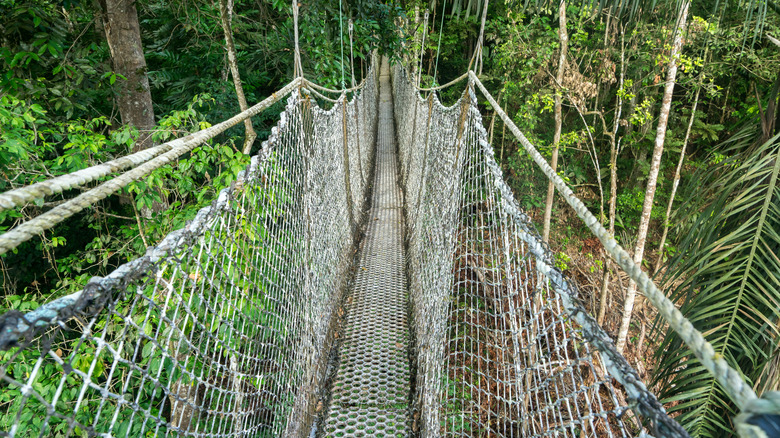
Gail Johnson/Shutterstock
If one color could be used to describe the country of Guyana, it would be green. Almost 90% of the country, the only one in South America where the official language is English, is blanketed in forest. This is a rugged nation, not known for its sublime beaches but for its wild interiors, a land of mountains, valleys, plains, and trees everywhere. Visitors can get a good handle on the natural allure of Guyana during a canopy walk in the Iwokrama rainforest. An area in the heart of the country with a research center, the forest is also home to the Atta Rainforest Lodge, where the canopy walk is set up.
After winding through the forest on a marked trail, visitors will come to suspension footbridges about 100 feet above the forest floor. Walking along them and stopping at viewing decks, guests can take in the sights and sounds of a tropical rainforest, forging unforgettable memories for the whole family. Back at the lodge, they might spot some of the many hummingbird species or tapirs that wander around the landscaped grounds.
Tackle the rapids of Chile’s Futaleufú River
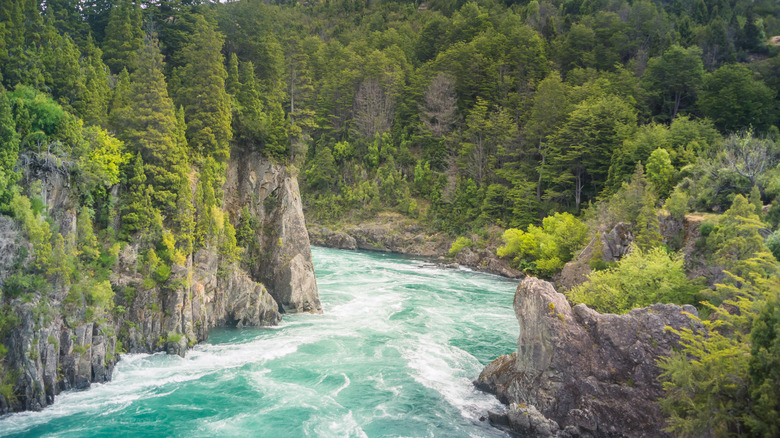
Guaxinim/Shutterstock
This activity is aimed at families with children aged 16 or over, an excursion that will surely get participants’ hearts pumping while promising liberal splashes of mountain water to help cool things down. Here in Chile’s Patagonia region, where the riverine adventure takes place, the rafting season runs during the summer months of December through March. The Futaleufú River is known among the whitewater rafting cognoscenti for its dependable rapids and powerful churns, and families looking for a thrilling escapade won’t be disappointed.
Trips last a day or more and pass via rapids with foreboding names such as Terminator, Himalayas, and Toro, some designated Class V (the most powerful). During the brief interludes between the roiling waters, paddlers can admire the scenery around them, from Andean forests to pretty waterfalls, and, if they are lucky, they might spy the great condor soaring overhead.

